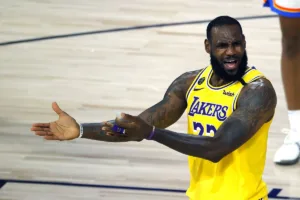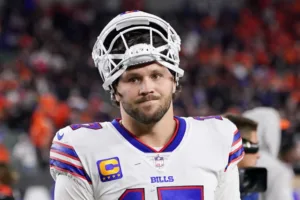We all know that some positions in football matter more than others. Obviously, a quarterback is more important than a tight end. However, when we talk about drafting different positions, do those positional values stay the same? Now GMs must consider the value of having players on a cheaper rookie contract, and how quickly they can add value on the field. That adds some interesting wrinkles to the old conversations about which positions matter more. This tier list takes into account the importance of the position overall, how quickly it takes rookies to contribute, where talent can be found in the draft, and how much of a bargain the rookie contract is. It should be emphasized that just because a position is lower ranked, that doesn’t mean they aren’t valuable. But specifically for the draft, there are positions that teams could benefit from focusing on more than others.
S-Tier: QB
This is an obvious answer but quarterbacks carry the most positional value in a draft. QB is the most important position on the field by a long shot, and the best place to find a franchise QB is in the draft, as difficult as that can be. It’s hard to say how much time it takes for a QB to be able to contribute to the team. Some like CJ Stroud can be game-changers within the first half of the season, while others like Jordan Love have benefitted from being able to sit for the first couple of seasons. Of course, some QBs will never become quality starters, even ones picked extremely high. While many of the best QBs have been taken in the First Round, there are still hidden gems who somehow play better in the NFL than they did in college. Tom Brady and Brock Purdy come to mind, both are QBs picked on Day 3 who have exceeded expectations, although one far more than the other.
An added benefit of finding value at the QB position is how absurdly cheap a rookie QB is compared to their second contract. Even with how much a Number 1 picks rookie contract is, that would be considered a bargain for even a decent starter on their second or third contract. If a QB turns out to be good early, that added cap space makes it much easier to build a Super Bowl-winning team around them, before they start to demand the Brinks truck to stay.
A-Tier: WR, CB, OT, EDGE
In the A-Tier of draft positional value are the players who revolve around the QBs actions. At the top of the tier, I have wide receivers as the second most valuable position in the draft. Because of their proximity to the QB and ability to make an impact on so many plays, they are already a very valuable position. In the draft, I think they become even more valuable. This is mainly because of their ability to contribute almost instantly. Puka Nacua is an incredible outlier as obviously, the best receiver of a draft doesn’t fall to the 5th Round in every draft. 1st round rookies are often able to be contributors in their rookie year without much-needed development. Yet even if you don’t pick a receiver in the first round, there is always talent in the later rounds to find. Besides that, late-round receivers can contribute to special teams, giving them extra value in late rounds.
Cornerbacks are similar to receivers in many of the same ways that make them valuable in the draft. Can contribute on special teams, valuable when cheap, but especially for their immediate impact. Look at Pat Surtain II and Sauce Gardener, who became the best corners in the league almost immediately. Maybe their value should be a little lower because, besides the freak talents, many young corners struggle at first. Yet the potential to have an elite player at an always-needed position is too tempting to value them any lower.
Offensive tackles, especially those that can play left tackle, are a premium position. There’s a reason why left tackles have the second-highest average salary behind only quarterbacks. Protecting a QB’s blindside is crucial for their success and safety. Getting quality play on a rookie deal is a pretty sweet bargain for a team. While playing offensive line at the NFL level can be very difficult for college linemen because of the added complexity and athleticism they face, However, top talent is usually able to acclimate pretty quickly.
Finally, edge rushers, whether in a 3-4 or 4-3 front are another crucial defensive position to target in the draft, at any time. The one drawback is that many edge rushers will usually have to spend some time gaining size or working on technique at the NFL level before they can unlock their full potential. Since most teams run their edge rushers in a rotation to make sure that offensive lines are always facing a fresh opponent, adding extra depth at edge is never a bad move. If they can contribute right away, great. If they need a bit more time, that’s fine as they can work throughout games to give starters a break, while still gaining valuable game reps.
All of these positions have the potential to quickly make an immediate impact on the game at premium positions, without any major drawbacks from being rookies. There’s a reason the first round is usually full of these positions.
B-Tier: IDL, LB
Interior defensive linemen often have the worst assignment on the defense: get clobbered by multiple giants every single play to let linebackers and edge rushers make plays instead. However, in recent years pass-rushing from the inside has become much more common among prospects. Similar to how most big men in basketball now have a three-ball, most interior D-Linemen have a pass-rush move they can use. While less valuable than the positions above them, they top the B-Tier because they don’t have the same growing pains the other position in this tier does.
Being an off-ball linebacker in the NFL might be the hardest position mentally besides QB. They have to know every other position’s job on every play, and relay adjustments or audibles to the rest of the team. That’s a lot of moving pieces to keep track of in addition to the various things they might have to do as soon as the ball is snapped. In addition, most modern LBs need to gain size or work on playing lower when they first transition to the NFL, as their athleticism will no longer carry them like it did in college.
C-Tier: IOL, RB, TE, S
These positions all have value problems in the modern NFL, they just aren’t able to make the same impact on every play as some positions. But that doesn’t mean that they aren’t important. I think most people know the pain of seeing your QB step up right into the arms of a pass rusher because your team didn’t have quality guards. They simply don’t carry as much value as tackles do in the modern game that is so focused on passing. Teams can often slide protections to protect the weak link, something harder to do with tackles.
Disrespecting running backs has become pretty popular in the modern NFL, and I hate to say it but I can see why, especially in the draft. The main problem to me is that their longevity is so much shorter than other positions. Why would you invest a top pick on a player whose best years are over far sooner than a wide receiver or tackles? In addition to that, there are often so many quality backs that can be found for much cheaper, money and pick-wise later on in the draft. It’s simply hard to justify a top-10 pick for a running back anymore.
Tight end is another rough position. For one, they just usually don’t make the same difference that receivers or running backs do. An average receiver produces much more than the average tight end does. You need to be Travis Kelce or George Kittle before you become as valuable as a top receiver. Second, tight end has a notoriously steep learning curve upon entering the NFL. There’s a reason that many top tight end prospects struggle in their rookie season before figuring it out later on. That’s what made Sam LaPorta’s breakout season so remarkable since he seemed to skip the growing pains.
Safeties are stuck here since they simply don’t have the same ability to make plays as often as other defensive positions do. They don’t rush the passer every play or cover a top receiver one-on-one. If you want a more in-depth read about why no one wants safeties in the modern NFL, you can read my longer thoughts right here at Envision the Play.
D-Tier: K, P
Do not take a kicker or punter with anything other than a Day 3 pick, it simply isn’t worth it. While having a great punter or kicker is very underrated, you can find one in the later rounds or as an undrafted free agent. Do not trade up to draft a kicker in the second round ahead of when Tyreek Hill and Dak Prescott went in the same draft. Please, just don’t. I don’t care that Jake Moody was taken at Pick 99 and played really well. It’s not worth it.
Photo Credits: Pro Football Focus






